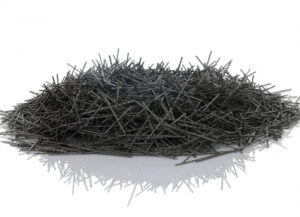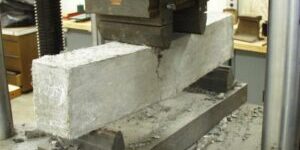According to scientific studies, yes.
Numerous studies confirm that with the use of high-performance static macrofibers, such as ArmoTec, insanely strong concrete can be produced, capable of replacing steel reinforcement in certain areas. The studies reveal that not every concrete fiber is suitable for replacing steel reinforcement.
The renowned research work of the Faculty of Architecture at the Budapest University of Technology and Economics, known as ‘The Big Break Test’, is highly comprehensive.
During the experiment, concrete reinforced with steel fibers, as well as synthetic micro- and macrofibers, were examined.
The synthetic fibers – including ArmoTec – are classified into two groups:
- Microfibers – their static role is negligible, their aim is to prevent the formation of microcracks during the solidification shrinkage of fresh concrete.
- Macrofibers – with proper dosage, they also have a static role. ArmoTec synthetic macrofiber is statically dimensionable.

During the study, concrete specimens with a length of 60 cm and a cross-section of 15×15 cm were manufactured.
The final result showed that static macrofibers significantly improve the strength properties of concrete, their application being much more advantageous compared to steel reinforcement:
- they do not corrode,
- they are lightweight,
- they mix well,
- their application results in much less CO2 emissions,
- they do not damage the mixing equipment.
Not only scientific studies confirm the strength of concrete fibers.
More than 2500 orders without any complaints. This is also an assurance of how small the chance of making a mistake is when choosing static concrete fibers. Static fibers not only replace the steel mesh but also exert their beneficial effects on concrete in so many ways that they reduce the risk of other failures:
- They reinforce the concrete in three dimensions, not just in one plane like the concrete mesh.
- They do not corrode, thus significantly increasing the lifespan of concrete.
- They eliminate the formation of shrinkage cracks during concrete curing, thus not only maintaining a beautiful surface but also significantly increasing frost and salt resistance.
An increasing variety of concrete fibers are appearing on the market.
What to look out for:
If you’re looking for concrete fibers to replace steel reinforcement, then you should only choose static macrofibers, so the designation is important. The thickness should be a minimum of 0.3 mm. The surface should be textured (preferably ribbed rather than corrugated) or otherwise roughened. This process prevents the concrete fiber from easily pulling out of the concrete in case of cracking.
The length also matters. Concrete fibers that are 40-50 mm long are usually sufficient; their pull-out resistance is quite high if their surface is ribbed. Fibers that are 10-20 mm long typically don’t have good enough pull-out resistance. The situation is similar with glass fibers, as their surface is smooth, and the fibers are very thin. Therefore, they cannot be relied upon statically and are not suitable for replacing steel reinforcement. However, they can prevent cracking caused by concrete shrinkage quite effectively.
Fibers suitable for replacing steel reinforcement must have a CE certificate and must be accompanied by a Declaration of Performance. Otherwise, they cannot be incorporated into structures or placed on the market. Examples of these documents can be found here: ArmoTec CE certificate and ArmoTec Declaration of Performance.
The use of static macrofibers is highly popular worldwide. Here are a few examples:
In New York, for the $11 billion East Side Access subway project, 100% macrofiber-reinforced concrete (without steel) is being used for the construction of the 21 km long subway tunnel. This has resulted in nearly a 50% cost savings compared to the traditional steel reinforcement system.
But this is not the only project of its kind. Static macrofibers have also been used to replace concrete reinforcement in projects such as the Sydney metro station, the British Docklands tram, and the Malaysian Bukit Berapit high-speed railway. In Hungary, the prefabricated grandstand elements of the Nagyerdő Stadium in Debrecen were reinforced with macrofibers, replacing steel reinforcement.
ArmoTec was not used in these projects. Products from other, much larger factories were installed, but ArmoTec has the same technical performance as these products. It also has EU certification documents. Based on our approval, ArmoTec can be incorporated into building structures.
From now on, anyone who wants to access static concrete macrofibers can do so easily, whether they’re doing concrete work at home using traditional methods or with a mixer truck. You can order it with a few clicks on this website, and you can start pouring concrete with it at home in just two days.
Leave the hassle of dealing with concrete reinforcement to others!
Best regards,
Levente Siposs
Supporter of Sustainable Renovations








